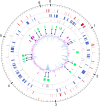The Nocardia cyriacigeorgica GUH-2 genome shows ongoing adaptation of an environmental Actinobacteria to a pathogen's lifestyle
- PMID: 23622346
- PMCID: PMC3751702
- DOI: 10.1186/1471-2164-14-286
The Nocardia cyriacigeorgica GUH-2 genome shows ongoing adaptation of an environmental Actinobacteria to a pathogen's lifestyle
Abstract
Background: Nocardia cyriacigeorgica is recognized as one of the most prevalent etiological agents of human nocardiosis. Human exposure to these Actinobacteria stems from direct contact with contaminated environmental matrices. The full genome sequence of N. cyriacigeorgica strain GUH-2 was studied to infer major trends in its evolution, including the acquisition of novel genetic elements that could explain its ability to thrive in multiple habitats.
Results: N. cyriacigeorgica strain GUH-2 genome size is 6.19 Mb-long, 82.7% of its CDS have homologs in at least another actinobacterial genome, and 74.5% of these are found in N. farcinica. Among N. cyriacigeorgica specific CDS, some are likely implicated in niche specialization such as those involved in denitrification and RuBisCO production, and are found in regions of genomic plasticity (RGP). Overall, 22 RGP were identified in this genome, representing 11.4% of its content. Some of these RGP encode a recombinase and IS elements which are indicative of genomic instability. CDS playing part in virulence were identified in this genome such as those involved in mammalian cell entry or encoding a superoxide dismutase. CDS encoding non ribosomal peptide synthetases (NRPS) and polyketide synthases (PKS) were identified, with some being likely involved in the synthesis of siderophores and toxins. COG analyses showed this genome to have an organization similar to environmental Actinobacteria.
Conclusion: N. cyriacigeorgica GUH-2 genome shows features suggesting a diversification from an ancestral saprophytic state. GUH-2 ability at acquiring foreign DNA was found significant and to have led to functional changes likely beneficial for its environmental cycle and opportunistic colonization of a human host.
Figures








Similar articles
-
Genome sequence of the human- and animal-pathogenic strain Nocardia cyriacigeorgica GUH-2.J Bacteriol. 2012 Apr;194(8):2098-9. doi: 10.1128/JB.00161-12. J Bacteriol. 2012. PMID: 22461543 Free PMC article.
-
Genomic characteristics, virulence potential, antimicrobial resistance profiles, and phylogenetic insights into Nocardia cyriacigeorgica.Ann Clin Microbiol Antimicrob. 2025 Apr 5;24(1):22. doi: 10.1186/s12941-025-00791-x. Ann Clin Microbiol Antimicrob. 2025. PMID: 40188140 Free PMC article.
-
Genome based analysis of type-I polyketide synthase and nonribosomal peptide synthetase gene clusters in seven strains of five representative Nocardia species.BMC Genomics. 2014 Apr 30;15(1):323. doi: 10.1186/1471-2164-15-323. BMC Genomics. 2014. PMID: 24884595 Free PMC article.
-
Genomics of Actinobacteria: tracing the evolutionary history of an ancient phylum.Microbiol Mol Biol Rev. 2007 Sep;71(3):495-548. doi: 10.1128/MMBR.00005-07. Microbiol Mol Biol Rev. 2007. PMID: 17804669 Free PMC article. Review.
-
Natural Products from Nocardia and Their Role in Pathogenicity.Microb Physiol. 2021;31(3):217-232. doi: 10.1159/000516864. Epub 2021 Jun 17. Microb Physiol. 2021. PMID: 34139700 Review.
Cited by
-
Comparison of Actinobacteria communities from human-impacted and pristine karst caves.Microbiologyopen. 2022 Feb;11(2):e1276. doi: 10.1002/mbo3.1276. Microbiologyopen. 2022. PMID: 35478281 Free PMC article.
-
Bioactive molecules from Nocardia: diversity, bioactivities and biosynthesis.J Ind Microbiol Biotechnol. 2019 Mar;46(3-4):385-407. doi: 10.1007/s10295-018-02120-y. Epub 2019 Jan 18. J Ind Microbiol Biotechnol. 2019. PMID: 30659436 Review.
-
Nocardia cyriacigeogica from Bovine Mastitis Induced In vitro Apoptosis of Bovine Mammary Epithelial Cells via Activation of Mitochondrial-Caspase Pathway.Front Cell Infect Microbiol. 2017 May 18;7:194. doi: 10.3389/fcimb.2017.00194. eCollection 2017. Front Cell Infect Microbiol. 2017. PMID: 28573110 Free PMC article.
-
Microbial risk assessment of Nocardia cyriacigeorgica in polluted environments, case of urban rainfall water.Comput Struct Biotechnol J. 2020 Dec 29;19:384-400. doi: 10.1016/j.csbj.2020.12.017. eCollection 2021. Comput Struct Biotechnol J. 2020. PMID: 33489008 Free PMC article.
-
Liver cirrhosis complicated with pulmonary Nocardia infection: A case report and literature review.Medicine (Baltimore). 2024 Dec 6;103(49):e40054. doi: 10.1097/MD.0000000000040054. Medicine (Baltimore). 2024. PMID: 39654192 Free PMC article. Review.
References
-
- Stackebrandt E, Sproer C, Rainey FA, Burghardt J, Pauker O, Hippe H. Phylogenetic analysis of the genus Desulfotomaculum: evidence for the misclassification of Desulfotomaculum guttoideum and description of Desulfotomaculum orientis as Desulfosporosinus orientis gen. nov., comb. nov. Int J Syst Bacteriol. 1997;47:1134–1139. doi: 10.1099/00207713-47-4-1134. - DOI - PubMed
-
- Yassin AF, Rainey FA, Steiner U. Nocardia cyriacigeorgici sp. nov. Int J Syst Evol Microbiol. 2001;51:1419–1423. - PubMed
Publication types
MeSH terms
Substances
LinkOut - more resources
Full Text Sources
Other Literature Sources
Molecular Biology Databases
Miscellaneous

